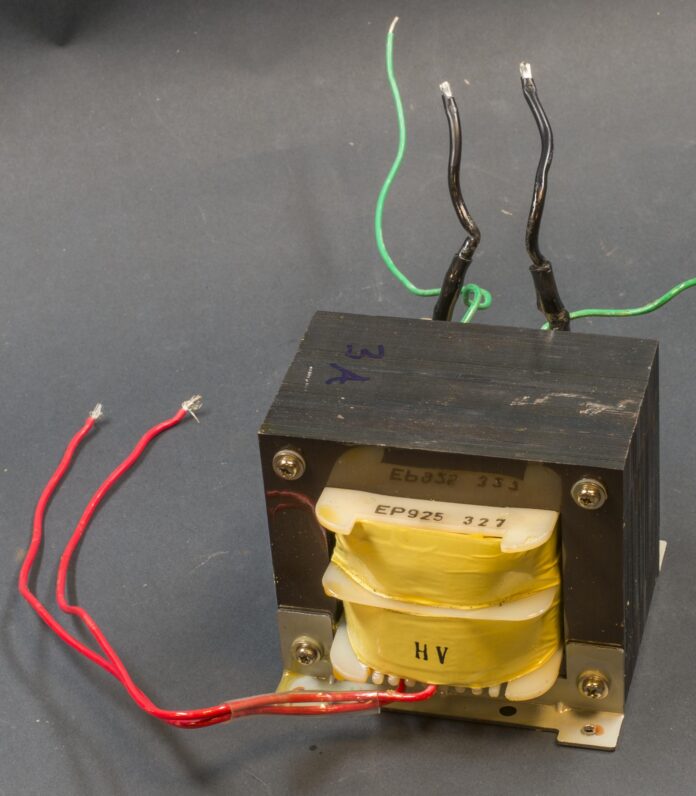Current Transformers (C.T.’s) are “instrument transformers” that produce alternating current in their secondary windings proportional to the current measured in their primary winding. Current transformers decrease high voltage currents to considerably lower values and provide a practical means for a conventional ammeter to safely check the actual electrical current flowing in an A.C. transmission line. A primary current transformer operates somewhat differently from a standard voltage transformer.
Current Transformer
Current transformers are distinct in that they typically contain only one winding. The main is linked in series to the line load. Primary windings may be a straight wire that goes through the center of the magnetic circuit when rated for a high current. A one-turn winding is visible on this straight conductor. When the primary winding has a low current rating, it may have several turns around the core.
The secondary is made up of multiple wire rounds wrapped around a core. The number of turns in a current transformer depends on its planned turns ratio. Current transformers don’t have a secondary winding that can regulate the primary current, like a two-winding potential transformer. A current transformer cannot change its direct current because of the load on the secondary.
What are the uses of current transformers (C.T.)?
It isn’t easy to manufacture measuring equipment such as ammeters, wattmeters (kWh), and protective relays capable of carrying hundreds or thousands of amperes. Furthermore, greater voltage levels make connecting these devices unsafe. These obstacles can be overcome with a C.T. C.T.’s have a turns ratio that creates a secondary current of 5A or 1A from the primary draft of the load.
An ammeter is attached to the secondary of the current transformer to measure the current flowing through a wire. Depending on the C.T.’s turns ratio, the ammeter is set up to provide 5A or 1A total deflection. The scale of the ammeter is modified following the turn ratio.
Read More: All the information you need to play the Green Glass Door game
Working principle
The transformer’s primary is fed with alternating current, and the measurement/sensing/protection device is attached to its secondary. A CT’s main usually has just one turn, which is nothing more than the current-carrying conductor passing through its window. Its primary sequence is never more than a few turns long. Depending on the current size to be stepped down, the transformer’s secondary contains numerous turns. The secondary coil is coiled around a laminated ferromagnetic core, with its ends connected to measurement devices.
The alternating current creates an alternating magnetic field in the ferromagnetic core. The secondary coil generates an alternating current on top of the heart during coiling. About the primary current, the turns ratio defines the size of the induced alternating current in the secondary.
The turns ratio of a C.T. is calculated by the measuring instrument’s primary current and full-scale deflection current. It is recommended that the secondary current of a current transformer be 5A in most circumstances.
What is a Voltage (or Potential) Transformer?
A potential or voltage transformer (P.T.) is an instrument transformer that gauges high voltage on the primary side by stepping down to a detectable voltage value. Technically, they can increase or decrease the primary voltage on the secondary side. Practically speaking, a voltage transformer lowers the voltage to a safe level detected by a voltmeter, wattmeter, or watthour meter, among other low-voltage devices. They are parallel-connected instrument transformers.
Current Transformers of Various Types
1. Portable Current Transformers
High-precision ammeters and power analyzers typically use these high-accuracy transformer types. Various transformer types are available, including clamp-on portable, flexible, and split-core transformers. High voltage circuits are frequently separated from sensing equipment with these gadgets.
2. Indoor Current Transformer
The use of indoor current transformers is every day in low-voltage circuits. A window is divided into three types: a wound window, a bar window, and a wound window. There are two windings on the wound type, as on the primary class. These are used for summing because of their high primary ampere values and excellent precision.
3. Standard Measuring Current Transformer
Ammeters and standard measuring current transformers that are stepped down to a typical output level of either 1 A or 5 A are used to handle high currents. The V. The V is matched to the condition of the current transformer. A spinning iron ammeter with a zero to 200 A rating is used in conjunction with a 200/5 FSD form (Full-Scale Deflection) of the current transformer. Once the output of the current transformer reaches 5 A, the calibration of the ammeter enables its identification.
4. Outdoor Current Transformers
Circuits with high voltage, such as switchyards and substations, are powered by external current transformers. There are two types of insulation available, oil-filled and SF6 gas-filled. An SF6 insulated current transformer is much lighter than an oil-filled form transformer. Current transformers are constructed as live tanks with the pinnacle tank attached as the main component. Because the primary conductor and tank capacities are equivalent, small bushings are employed in this configuration. Whenever there is more than one ratio for the C.T., the split primary winding is used.
What variations of CT and PT are there?
A voltage step-down and current step-up transformer is a potential transformer. Current transformers come in four primary categories: Wound Types CT, Toroidal CT, Bar Type CT, and Summation CT. Potential transformers come in two main varieties: capacitive and electromagnetic.
Current transformer applications
Current transformers use ammeters, kWh meters, power factor meters, and energy meters to measure current. It is used in the operation of safety relays. Clamp meters clamp around a conductor carrying the current to measure current.
How do Current Transformers function?
A Current Transformer operates on the same basic idea as mentioned before. Alternating magnetic flux is created when an Alternating Current passes through the primary winding; this alternate magnetic flux causes an Alternating Current to follow in the secondary winding.
When compared to other varieties, Current Transformers have a significant operating difference. The primary winding of a C.T. is frequently simply one or a few turns. It might be a bar or a conductor inserted through a hole. It might also be a strong duty wire wrapped around the core. A laminated core of low-loss magnetic material would be used on the secondary for covering it with many turns.











